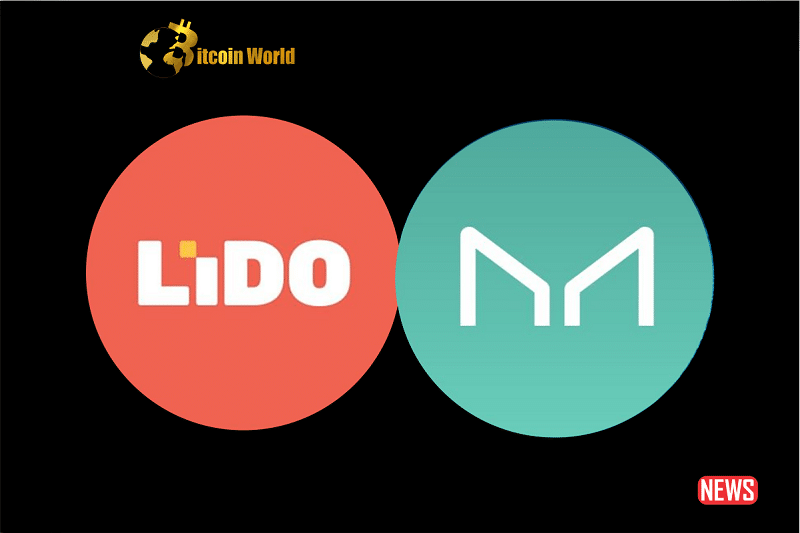The world of decentralized finance (DeFi) is a dynamic arena, constantly evolving with new developments and shifting tides. For a long time, MakerDAO, with its pioneering stablecoin DAI, reigned supreme as the DeFi protocol with the highest Total Value Locked (TVL). However, the landscape has changed, and a new leader has emerged: Lido Finance. Let’s dive into the factors that have led to this significant shift in the DeFi hierarchy.
The Tale of Two TVLs: MakerDAO vs. Lido Finance
Imagine a tug-of-war where the rope represents the total value locked in these protocols. For MakerDAO [MKR], the past few months have seen a noticeable slip. Data from DefiLlama reveals a 9% decrease in MakerDAO’s TVL in the last month alone. On the other side of the rope, Lido Finance [LDO] is pulling strong, experiencing a 4% growth in TVL during the same period.
This divergence is more than just a fleeting moment. Lido Finance confidently crossed the $10 billion TVL milestone in March and hasn’t looked back, currently boasting an impressive $11.99 billion. In contrast, MakerDAO’s growth over the past five months has been a modest 17%. What’s behind this shift?
The Shapella Effect: A Tailwind for Lido
The highly anticipated Ethereum Shanghai Upgrade, also known as Shapella, went live on April 12th, and it acted as a significant catalyst in this DeFi power shift. Shapella unlocked the ability to withdraw staked ETH, igniting a surge in liquid staking activity. Lido Finance, a leading platform for liquid staking, was perfectly positioned to capitalize on this.
Why Did Lido Benefit More?
- Delayed Withdrawals, Increased Deposits: While some staking platforms enabled immediate withdrawals post-Shapella, Lido opted for a slightly delayed approach. This strategic decision inadvertently encouraged more ETH deposits as users felt less urgency to withdraw, contributing to their TVL growth.
- Dominance in Liquid Staking: Lido has established itself as a dominant player in the liquid staking space, offering users the ability to stake ETH and receive stETH in return, which can be used in other DeFi applications. This established infrastructure and user base naturally attracted more deposits after Shapella.
Dune Analytics data underscores this point, showing a 9% increase in ETH staked with Lido since Shapella, translating to a 5% rise in their TVL.
MakerDAO’s Challenges: The DAI Depeg Incident
While Lido was riding the wave of Shapella, MakerDAO faced its own set of challenges. The momentary depeg of its DAI stablecoin in March, triggered by the unexpected collapse of Silicon Valley Bank, significantly impacted its TVL.
The Ripple Effect of the Depeg:
- USDC’s Instability: During the SVB crisis, USDC, a significant collateral asset for DAI, temporarily lost its dollar peg.
- DAI Supply Contraction: This instability led to a decrease in confidence, causing DAI’s supply to shrink by 25%, according to data from Maker Burn.
- Reduced Borrowing Demand: With fewer DAI tokens in circulation, the demand for borrowing the stablecoin naturally decreased.
- Impact on TVL: Lower borrowing demand translates to less collateral locked in MakerDAO’s smart contracts, directly hindering its TVL growth.
In essence, the DAI depeg created a ripple effect, impacting the fundamental mechanics that drive MakerDAO’s TVL.
MKR’s Price and Network Activity: A Reflection of the Challenges
The challenges faced by MakerDAO are also reflected in the performance of its governance token, MKR. CoinMarketCap data reveals a double-digit decline in MKR’s price over the last 30 days, with the token currently trading around $653.16.
Diving into On-Chain Data:
Santiment’s on-chain data paints a clearer picture of the challenges:
| Metric | Change (Last 30 Days) |
|---|---|
| Daily Active Addresses Trading MKR | -43% |
| New Addresses Created Daily to Trade MKR | -32% |
| MKR Supply on Exchanges | Increased |
| MKR Supply Outside Exchanges | Decreased |
These figures suggest a decrease in network activity and new demand for MKR. The increase in supply on exchanges, coupled with a decrease in supply outside exchanges, indicates that more investors are moving their MKR holdings to exchanges, likely to sell, further contributing to the price decline.
Navigating the Ever-Changing DeFi Seas
The shift in TVL dominance from MakerDAO to Lido Finance highlights the dynamic nature of the DeFi space. While MakerDAO grappled with the fallout from the DAI depeg, Lido strategically capitalized on the Ethereum Shapella upgrade. This isn’t to say MakerDAO’s journey is over. The protocol continues to be a significant player in DeFi and is likely working on strategies to regain momentum.
Key Takeaways:
- External Factors Matter: Events like the SVB collapse can have significant and unexpected consequences for DeFi protocols.
- Innovation and Adaptability are Crucial: Lido’s success post-Shapella demonstrates the importance of being well-positioned to capitalize on new developments.
- Stablecoin Stability is Paramount: The DAI depeg serves as a reminder of the critical role stability plays in the success of stablecoin-dependent protocols.
- Community and Governance: How protocols respond to challenges and adapt their strategies is often influenced by their governance mechanisms and community involvement.
Conclusion: A Constant State of Flux
The DeFi landscape is a constantly evolving ecosystem, and the shift in TVL leadership between MakerDAO and Lido Finance is a prime example of this. While Lido currently holds the top spot, the future remains uncertain. Protocols must remain agile, innovative, and resilient to navigate the inevitable challenges and opportunities that arise in this exciting and rapidly developing space. The race for DeFi dominance is far from over, and it will be fascinating to see how these and other protocols adapt and compete in the months and years to come.
Disclaimer: The information provided is not trading advice, Bitcoinworld.co.in holds no liability for any investments made based on the information provided on this page. We strongly recommend independent research and/or consultation with a qualified professional before making any investment decisions.


